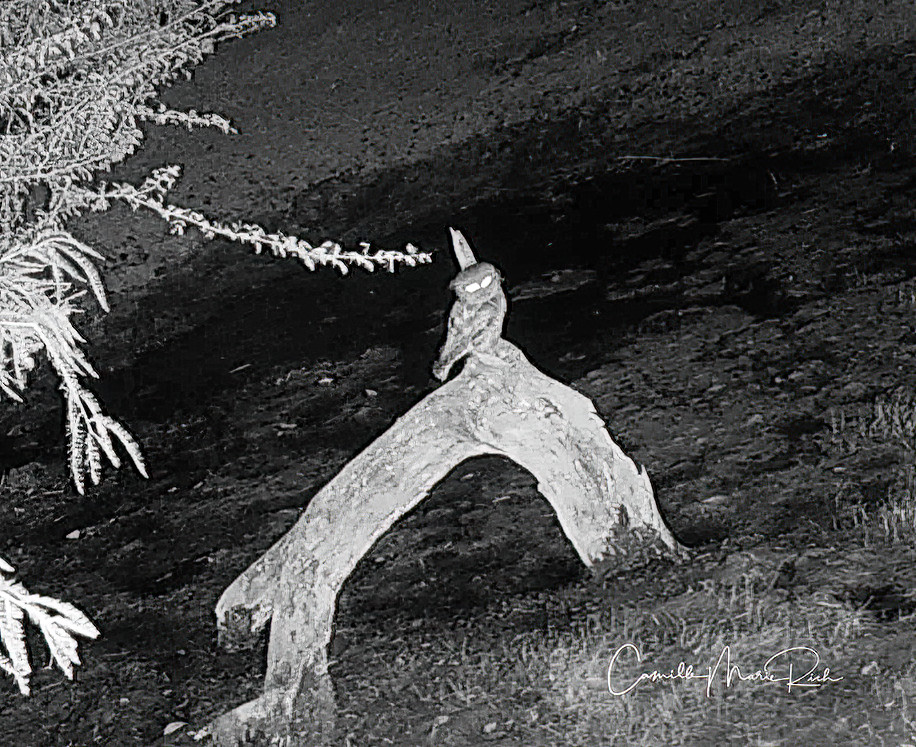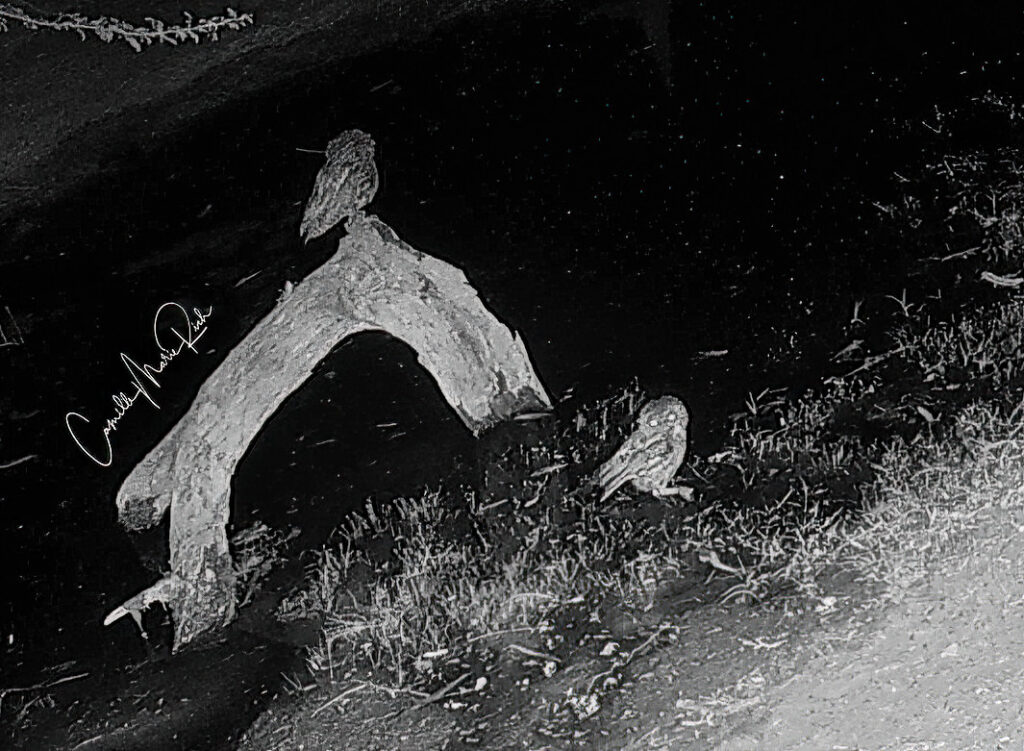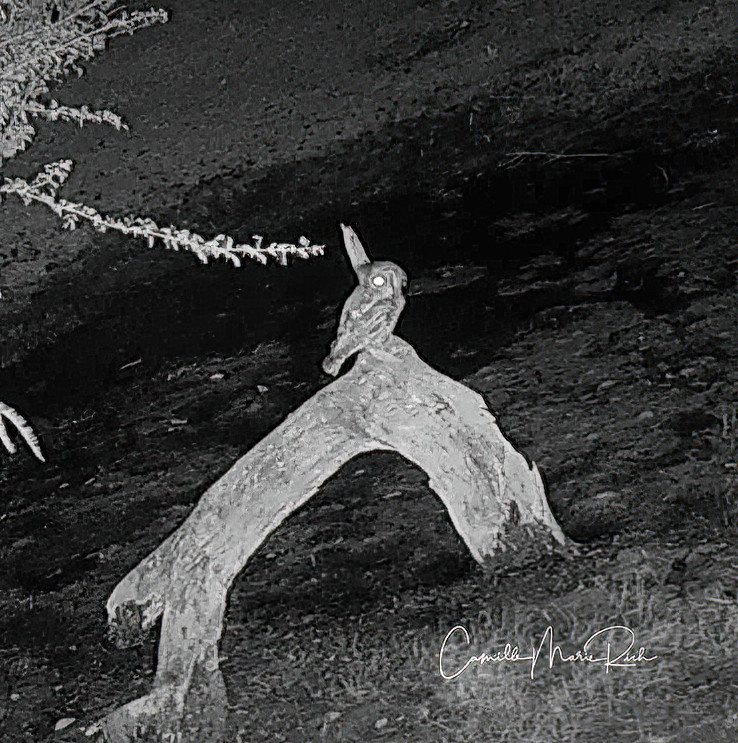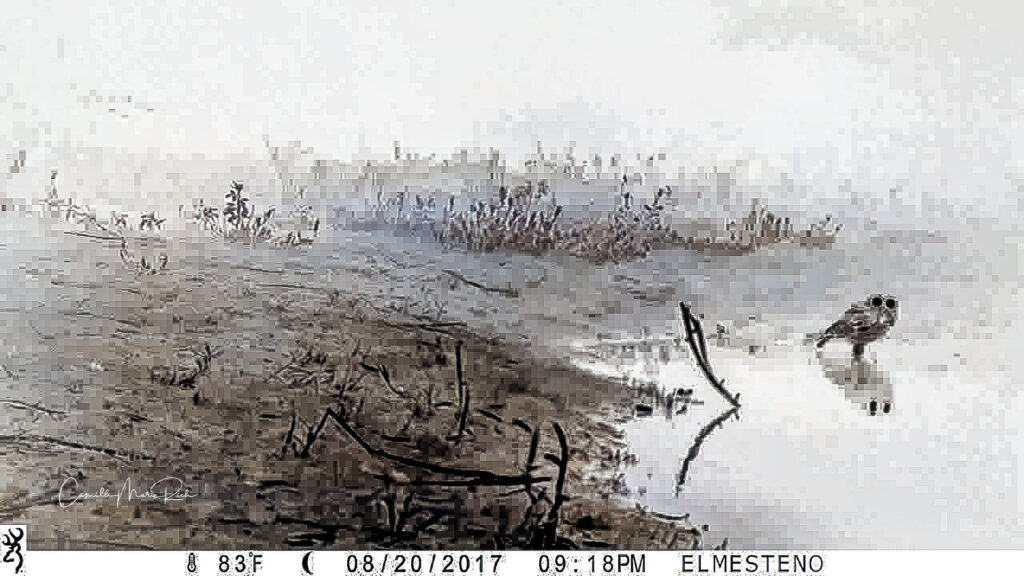OWLS
On fuzzy-edged feathers, flight is effortlessly taken—gliding. Dipping. Diving.
Wing beats are soundless—stealthy. Swooping. Soaring.
Listen to the powerful silence—remarkable. Calming. Reassuring.
Syllables whispered out into the dark—song. Sing. Rejoice.
By CmR
Throughout the ages, much has been written and noted about the owl. Many cultures have revered, or even feared, the owl. Some even subscribing to the notion that owls are signs of impending doom or death. I would agree with that if I happened to be a rodent, perhaps. Otherwise, I believe the superstition surrounding owls to be great fiction.
Out on the South Texas Sand Sheet, my trail cameras have captured Eastern Screech-Owls, and even a few Great Horned Owls, over the years. Despite zero trail camera appearances, I have also observed Barn Owls on numerous occasions. Each owl encounter, whether via trail camera footage or an in-person observation, has presented an exceptional opportunity to learn more about these nocturnal birds of prey.
As both a student and a steward of the South Texas Sand Sheet, I have prioritized preserving and maintaining habitat for owls. Additionally, I have tried my best to be a great learner—to observe and absorb as much as I possibly can about them. Now, the final piece of my participatory scientist’s educational journey on owls, to date, is for me to share what I have learned about them with you.
Over the course of many years of consistent camera trapping to document fauna at the watering hole, owls have made numerous cameo appearances after dark. They have graciously supplied me with lessons on how they turn their head towards sounds in the dark, their own version of a tail waggle, the way they shake their wet feathers to dry off, even to how careful they are when they kind of crouch down and lean over to get a sip of water.
What I think it comes down to…
My overall takeaway from years of owl experiences via my “trail camera relationship” with them is this: The presence of an owl on your property can be a sign of a balanced ecosystem—a healthy habitat whereby owls take up residence on a property and make it their home. All they need is a nesting site, a food source, and a steady water supply.
Native American beliefs…
“In Nature, everything has its own place and purpose. Humans must work at entering the natural environment in ways that demonstrate cooperative thinking in accordance with the wisdom of Nature. When you meditate on giving thanks, first give thanks for Mother Earth and all the living things: the four-legged ones, the winged ones, and everything that has been touched by the Great One, including even the rocks and the trees.”
“Meditations with The Cherokee: Prayers, Songs, and Stories of Healing and Harmony,” by J. T. Garrett, Ed. D. Published by Bear & Company, Rochester, Vermont, 2001.
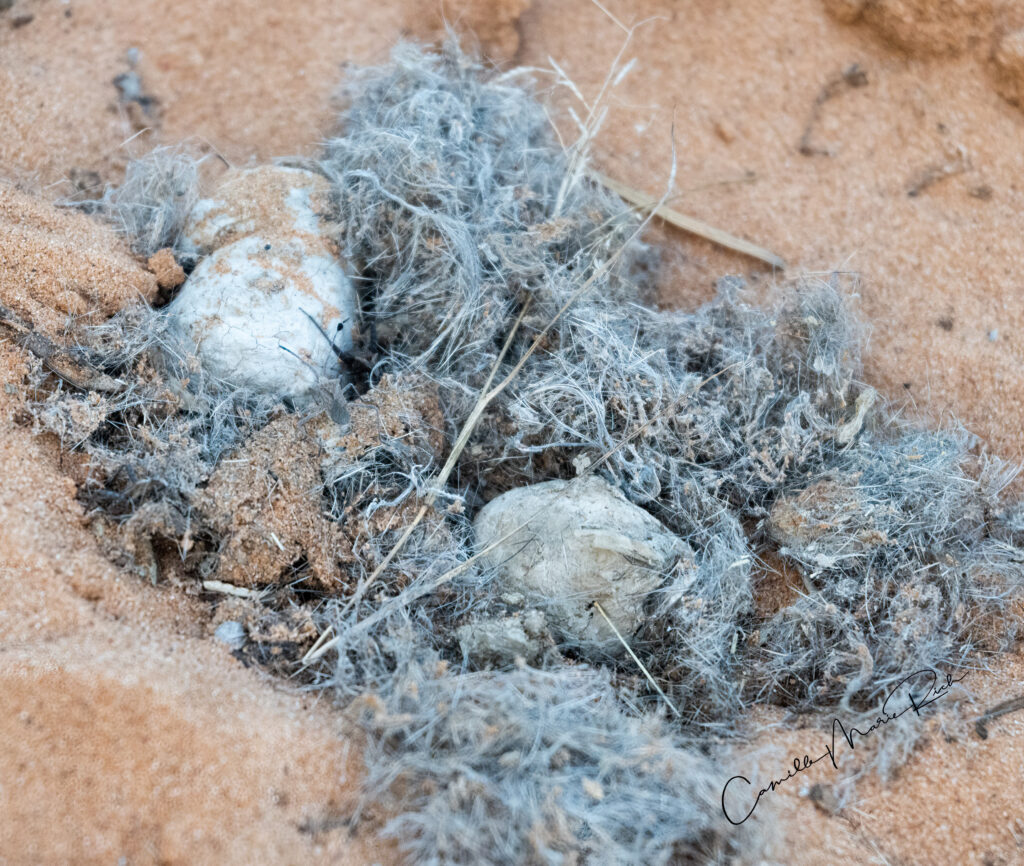
“Owl is a creature of the night and has been symbolically associated with wisdom because it can see what others cannot. It is the only bird that flies in total silence…Owl is symbolic of discernment…”
“Shamanic Experience: A Practical Guide to Psychic Powers,” by Kenneth Meadows. Published by Bear & Company. Rochester, Vermont. 1991, 2001, and 2003.
Mesteño Mini Movie featuring owls of the South Texas Sand Sheet:
Birding and feather experts weigh in…
“19 species in 11 genera, all in the family Strigidae except Barn Owl in Tytonidae. Owls are mainly nocturnal predators, distinctive, with large eyes facing forwards and surrounded by facial disk. All have hooked bills and needle-sharp talons, used for catching animal prey. Forage mainly by perching and listening or watching for prey, and different species specialize in different prey: Many smaller species are insectivores, larger species take mainly mammals…Owls do not build nests, most species nest in cavities or crevices and readily accept man-made structures such as birdhouses: some use old nests of other birds or squirrels.”
“The Sibley Guide to Birds, Second Edition,” written and illustrated by David Allen Sibley. Published by Alfred A. Knopf, New York, 2014.

“Barn Owls (Tytonidae) and Typical Owls (Strigidae): Leading primaries are often curved near the tip. All flight feathers of the wing have a fuzzy appearance. Strong barring or spotting is always present. [Note: Some hawks and kites also have fuzzy wing feathers, but to a much lesser degree.]”
“A Guide to North American Species Bird Feathers,” by S. David Scott and Casey McFarland. Published by Stackpole Books, Mechanicsburg, Pennsylvania, 2010.
How do they fly so quietly?
“Owls achieve almost noiseless flight and can swoop down on their prey unheard. Two factors work together to accomplish this. First, large wings and a light body enable the owl to support itself easily and quietly in flight. A heavy-bodied bird requires hard-working wings that tend to be noisy. If you have ever heard a startled quail take flight, you have some idea of the noise some birds’ wings can make. Second, most owls have comb-like serrations on the leading edge of wing feathers that break up the turbulent air that typically creates a swooshing sound. Those smaller streams of air are further dampened by a velvety texture unique to owl feathers and by a soft fringe on a wing’s trailing edge. These structures together streamline the air flow and absorb the sound produced by the owl’s beating wings. Owls also have whisker-like feathers that cover the beak area and they have feathers covering their feet all the way to the talons. This is yet another adaptation owls have to be more silent flyers.”
Online Source: Texas Parks & Wildlife: Introducing Birds to Young Naturalists: Owls
Calls of the Eastern Screech-Owl:
“Tremolo song a long, whistled trill on one pitch, up to three seconds long. All calls given by both sexes, but female voice slightly higher-pitched than male.”
“The Sibley Guide to Birds, Second Edition,” written and illustrated by David Allen Sibley. Published by Alfred A. Knopf, New York, 2014.
Owl Species in Texas:
“Barn Owl, Flammulated Owl, Western Screech-Owl, Eastern Screech-Owl, Great Horned Owl, Ferruginous Pygmy-Owl, Elf Owl, Burrowing Owl, Barred Owl, Long-eared Owl, and Short-eared Owl.
Online Source: Texas Parks & Wildlife: Introducing Birds to Young Naturalists: Owls

Owls in my yard…
As I bring this article to a close, I would like to share a bit about my urban experiences with owls. You see, I have lived at the same residence for over twenty years. It has not been until the last five to eight years—that as large tracts of remaining brush have been cleared around me to make way for new subdivisions and commercial centers—I have heard owls in my own backyard. Some of the owls stayed for a few days, and some of the owls even stayed long enough to raise their young.

Can you spot the owlet in the photograph above?
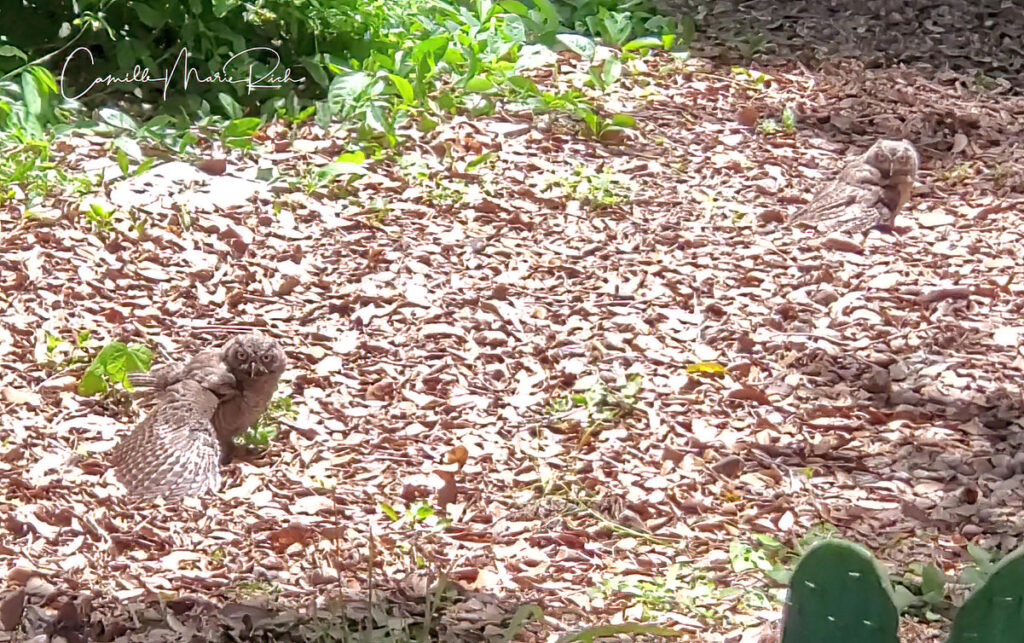
Talk about fantastic camouflage!
Noteworthy guests in my backyard and the neighborhood I live in have included the Great Horned Owl, Barn Owl, and Eastern Screech-Owl. I once even had Eastern Screech-Owls nesting in a tall, dead Crepe Myrtle that that I never cut down, because it provided superb habitat for all sorts of creatures. Watching their owlets fledge was phenomenal! A treasured nature story I will never forget!
What can we do to help owls?
- Owls can suffer poisoning (and potentially death) from eating poisoned prey.
- Use traps rather than poisons to control rodents.
- Reduce the use of insect pesticides.
- Leave dead trees, including dead palm trees, available for owls to both roost and nest in.
- Stay alert for owls on roads, or near roadsides, at night.
- Add a nest box specifically designed for owls to your property.
- Reduce unnecessary lighting at night in and around your property.
Related, published articles by Fellow Texas Master Naturalists:
- Rio Grande Valley Chapter Texas master Naturalist: Anita’s Blog — “The Dark of Night” by Anita Westervelt
- Rio Grande Valley Chapter Texas Master Naturalist: “Tiger of the Treetops” by Diane Hall
Text sources / resources for this article:
- “A Guide to North American Species Bird Feathers,” by S. David Scott and Casey McFarland. Published by Stackpole Books, Mechanicsburg, Pennsylvania, 2010.
- “Meditations with The Cherokee: Prayers, Songs, and Stories of Healing and Harmony,” by J. T. Garrett, Ed. D. Published by Bear & Company, Rochester, Vermont, 2001.
- “Shamanic Experience: A Practical Guide to Psychic Powers,” by Kenneth Meadows. Published by Bear & Company. Rochester, Vermont. 1991, 2001, and 2003.
- “The Sibley Guide to Birds, Second Edition,” written and illustrated by David Allen Sibley. Published by Alfred A. Knopf, New York, 2014.
Online sources / resources for this article:
- Texas Parks & Wildlife: Introducing Birds to Young Naturalists: Owls
- Audubon: 13 Fun Facts About Owls
- iNaturalist on Screech-Owls
- iNaturalist Barn Owl Observations
- iNaturalist Great Horned Owl Observations
- iNaturalist Owls of the World Observations
- The Cornell Lab: All About Birds: Barn Owl
- The Cornell Lab: All About Birds: Eastern Screech-Owl
- The Cornell Lab: All About Birds: Great Horned Owl
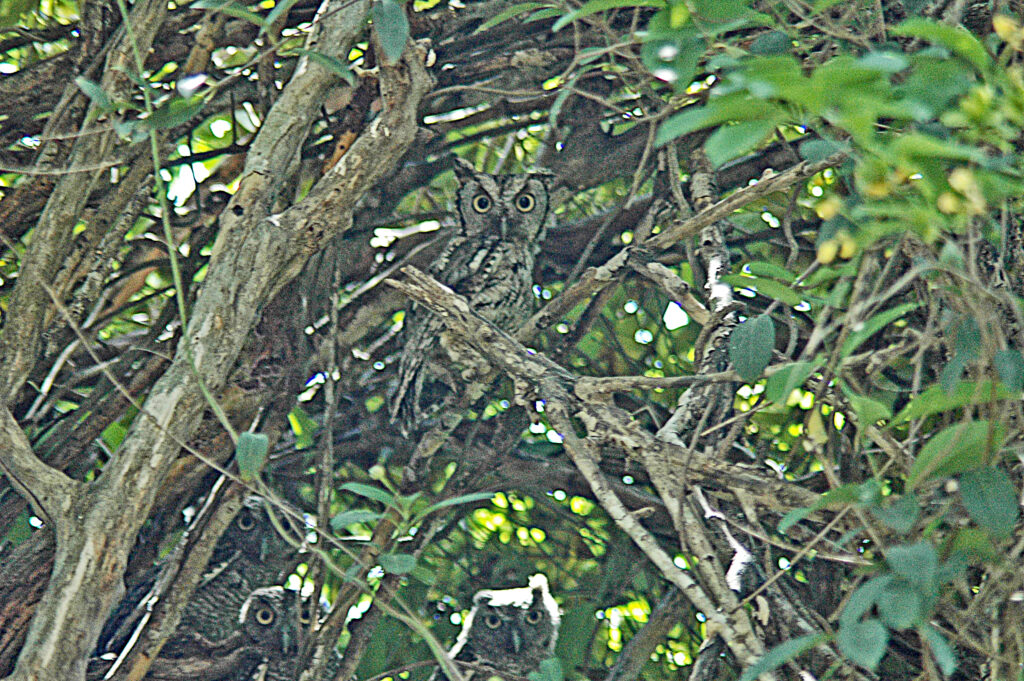
Photo Credit: M. A. Jackson
